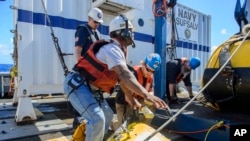A search team using sophisticated scanning sonar has found the wreckage of a vessel believed to be the cargo ship El Faro, which went missing with 33 crew members Oct. 1 during Hurricane Joaquin, the U.S. National Transportation Safety Board said late Saturday.
A statement from the agency said searchers aboard the USNS Apache, a Navy vessel contracted for the search, thought they located wreckage of the ship at 1:36 p.m. EDT (1736 GMT) at a depth of about 15,000 feet (4,572 meters) of water in the vicinity of the ship's last known position. The statement added that the wreckage was detected on the fifth of 13 surveying passes.
"To confirm the finding, specialists on Apache will use ... a deep-ocean remotely operated vehicle to survey and confirm the identity of the wreckage. This survey could begin as early as November 1,'' said the statement, released in Washington by the NTSB's Peter Knudson. It added that the wreckage spotted in the depths was "consistent with a 790-foot cargo ship, which from sonar images appears to be in an upright position and in one piece.''
The 790-foot (240-meter) El Faro was reported missing east of the Bahamas, according to the Coast Guard.
The El Faro's captain had called in before the vessel disappeared, saying the ship had lost its engine power during its voyage from Jacksonville to San Juan, Puerto Rico. The captain, Michael Davidson, said the ship was listing and taking on water.
The Coast Guard searched for the ship for days after the El Faro disappeared in the storm, finding debris and one body in a survival suit.
The El Faro was scheduled for retirement from Caribbean duty and for new retrofitting for service between the West Coast and Alaska, company officials have said. Both the El Faro and its sister ship were slated to be replaced by two new ships. Aboard when it sank were five engineers from Poland, who were working on the retrofitting as the ship sailed to Puerto Rico.
NTSB investigators said Davidson intended to pass 65 miles (104 kilometers) from the center of the storm, a decision maritime experts said was risky.
Knudson's statement said that if the wreckage detected is confirmed to be the missing cargo ship, attempts will be made to locate and recover the critical voyage data recorder. It added that the next phase of operations was expected to take up to 15 days to complete in ideal conditions, longer in poor weather.








